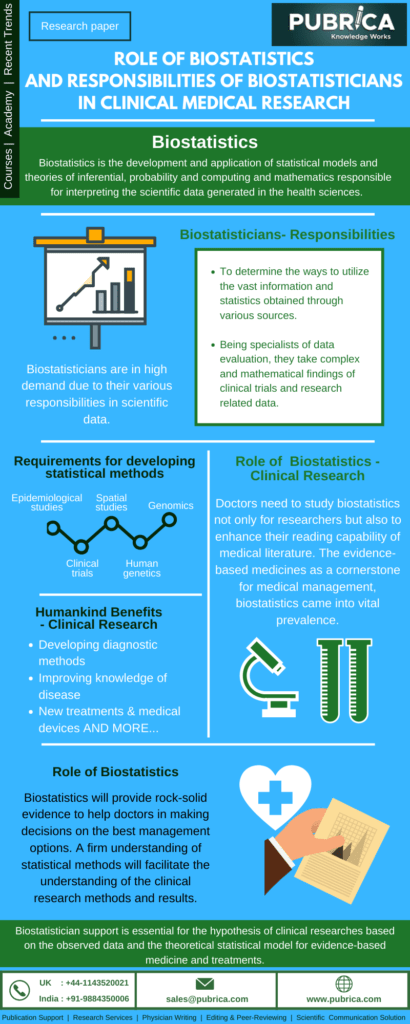
The Impact of 3D Medical Animation in the Healthcare Industry
October 12, 2019
Pre-or post-publication Peer review of Scientific Manuscripts: Thoughts on Pros and Cons
October 31, 2019Role of Biostatistics and Responsibilities of Biostatisticians in Clinical Medical Research
“You can have data without information, but you cannot have information without data.” —
Daniel Keys Moran
Making sense of all the data relating to living organisms and transforming them into knowledge by using quantitative skills are the work of biostatisticians.
The tools of the biostatistics help to find answers for pressing research questions in biology, medicine, and public health. They may answer questions like
- How a new drug works?
- What causes cancer?
- What is the reason for many diseases?
- How long could a person survive with a particular disease?
So, what is biostatistics and its Applications?
Biostatistics is the development and application of statistical models and theories of inferential, probability and computing and mathematics responsible for interpreting the scientific data generated in the health sciences. Statistical methods encompass designs of a wide range of biological experiments. With the onset of pharmaceutical studies and clinical trials, it has developed in the directions of clinical trial methodology, general linear models of various types, survival analysis, longitudinal models, and health outcome research. It infers the experimental data in the health sphere to understand countless pressing and crucial health and other development issues like:
Application of biostatistics
| Medicine | Public Health/Health economics and policy | Large Data | Future |
| Chronic diseases such as DiabetesAIDSCancerNeurological conditionsPalliative care | Environmental health The relationship between genetics & the environmentSmoking cessationPreventionutilization | Medicare data Brain imaging Genomics | Cost pattern identification Health data mining Illness behavioural profiles |
The Biostatisticians in the field of Medical Research:
Biostatisticians ( PhD or post-graduate speciality in statistics or Medical/health or Epidemiology) are in high demand due to their various responsibilities in scientific data. They also collaborate with informatics, experts, scientists, and researchers for various functions. They consider the variables in subjects like patients, communities, or population to understand them and also make sense of different sources of variation. It is to achieve their ultimate goal of solving problems in public health by disentangling the received data and make valid inferences. It is the reason they are in demand in government agencies and legislative offices. Their research is used often to influence changes at the policy-making levels.
The responsibilities of Biostatisticians:
- To determine the ways to utilize the vast information and statistics obtained through various sources like genomics, clinical trials, experimental studies and observational and longitudinal studies for public health.
- Being specialists of data evaluation, they take complex and mathematical findings of clinical trials and research related data. They then translate them into variable information to make public health decisions.
- Biostatisticians are required to develop statistical methods for the following:
- Clinical trials to study and evaluate treatments, screening and prevention methods in the population (e.g. Evaluating protocol in terms of study rationale, study objectives, study design, sample size calculation, statistical analysis of primary endpoints, statistical analysis of secondary endpoints, treatment of missing data, informed consent, insurance issues, economic issues)
- Epidemiological studies of the origins of disease in humans
- Spatial studies of the geographical distribution of disease and risk factors
- Genomics which is the study of the biological activity of genes as they relate to disease and treatments
- Human genetics a study of the genetic differences among diseases and disease states
Biostatistics is responsible for public health all over the world with data collection and its interpretation by various ways.
What are the roles of biostatistics in clinical research?
Many students studying medicine find it unnecessary in their initial years of study to learn statistics. But the reality is many profound doctors feel the need biostatistics since in the time of their study it was not in the medical study curriculum. The doctors need to study biostatistics not only for researchers but also to enhance their reading capability of medical literature. Only with the introduction of evidence-based medicines as a cornerstone for medical management, biostatistics came into vital prevalence.
What is clinical research?
All systematic researches carried out on human beings to generate data for discovering or verifying the pharmacological, clinical or adverse effects with the objective of determining efficacy and safety of the new drug are called clinical researches. They bring in the following benefits to humankind:
- Assess the relative benefits of competing therapies
- Investigating proposed medical treatments
- Establishing optimal treatment combinations
- Improving knowledge of disease
- Developing diagnostic methods
- New treatments & medical devices
The role of biostatistics in clinical research methodology:
Guidelines of evidence-based medicine are squarely depended on meta-analysis. It is, in turn, is based on many randomized controlled clinical types of research. Only this will provide rock-solid evidence to help doctors in making decisions on the best management options for patients. A firm understanding of statistical methods only will facilitate the understanding of the randomized clinical research methods and results. Hence biostatistics plays an important role in evidence-based medicine, which is the base for doctors to recommend treatments for patients now.
The other roles of biostatistics in clinical research:
- It is crucial for any clinical research from design, conduct, analysis, and reporting in terms of controlling and minimizing biases, confounding factors, and measuring random errors.
- They provide formal accounting for sources of variability n patients’ response to treatment.
- It helps the clinical researcher to form reasonable and precise inferences from all collected information to make the correct decisions during the presence of uncertainty.
- Since clinical research is critical for a new drug for its efficacy, it is helped by biostatistics in drug development. It helps in the following areas:
- Protocol & study design (e.g. randomized trials)
- Data management
- Sample size calculation for dose response studies, microarray studies and Bayesian approaches
- Misclassification
- Effect modification
- confounding
- Study implementation
- Study monitoring for safety and efficacy
- Data analysis
- Data reporting
Biostatistician support is essential for the hypothesis of clinical researches based on the observed data and the theoretical statistical model for evidence-based medicine and treatments.
Tags:
Biostatistical Programming | Clinical trials | journal Publishing services | Scientific Editing Services | Medical Writing Services | scientific research writing service | Scientific Medical communication service
Related Topics:
Literature gap and future research

